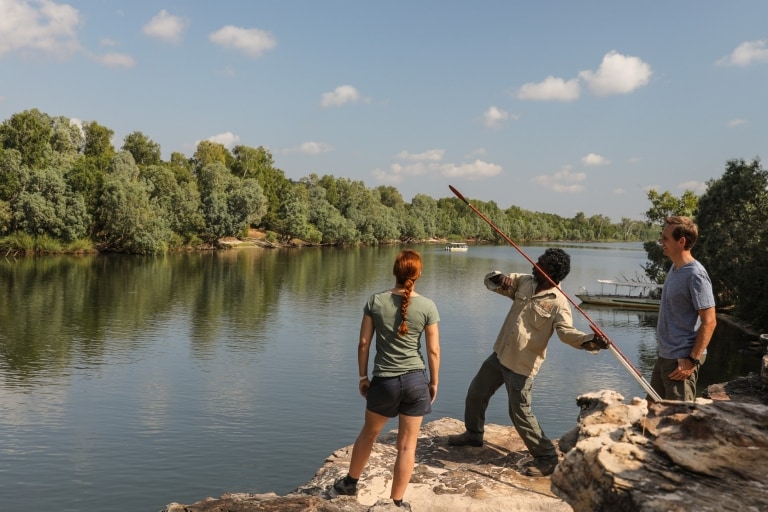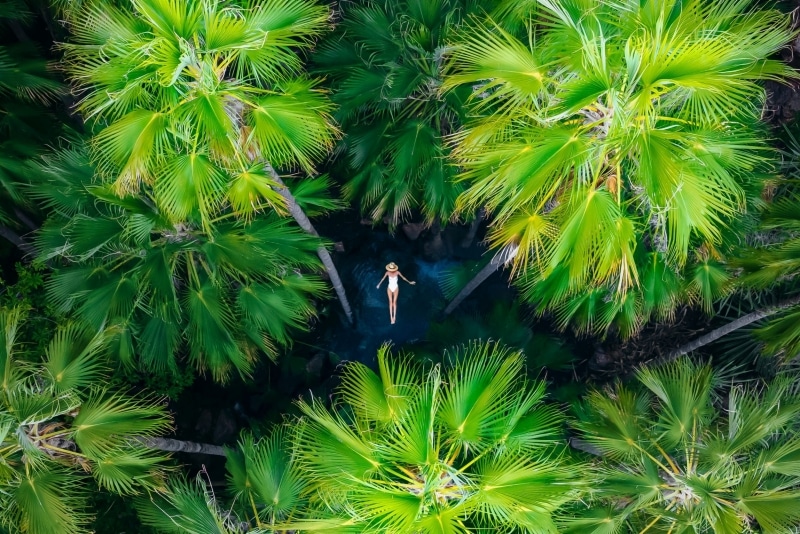
Understanding Aboriginal cultures
A visit to Australia without an Aboriginal tourism experience is like going to Bondi without a surfboard. Or going outback and never seeing a kangaroo.
From gateway destinations like Sydney, to Central Australia or the red earth of the Kimberley, Aboriginal people across the country are waiting to tell their stories and share the meaning of their cultures and way of life.
“The main thing overseas visitors want to experience is the Aboriginal culture,” says SeaLink – Tiwi by Design tour guide, Buffy Warlapinni. “People are starting to get more interested in our way of culture.”
Aboriginal culture dates back more than 50,000 years. It existed long before Stonehenge, predates the Pyramids and is older than the Acropolis. What’s more amazing is that this culture can be experienced today.
And who better to introduce you to the world’s oldest continuous culture than somebody who lives, breathes and dreams it every day — an Aboriginal guide, one of Australia’s First Peoples, who call this vast continent their home.

"Aboriginal culture starts with its people. Aboriginal guides open a door into a world that many people don’t know still exists. A world where past, present and future meet. There’s nothing more exciting for a traveller than a totally new experience. That’s what memories are made of."
- Dr Aden Ridgeway, Gumbaynggirr man and former chair of Indigenous Tourism Australia
Who are Australia’s Indigenous peoples?

SeaLink, Tiwi by Design, Tiwi Islands, Northern Territory © Tourism Australia
Australia’s Indigenous peoples have lived on the country’s vast lands for tens of thousands of years. They are the world’s oldest living culture, and their unique identity and spirit continues to exist in every corner of the country.
While ‘Aboriginal’ or ‘Indigenous’ may be used to describe Australia’s First Peoples, they see it differently. “We are one, we are different to each other, and we are many,” says Dr Ridgeway.
The Indigenous people from the Torres Strait Islands, which are part of the state of Queensland, are regarded as distinct from the Aboriginal peoples of mainland Australia and Tasmania.
Torres Strait Islanders come from the islands of the Torres Strait between the tip of Cape York in Queensland and Papua New Guinea and share many cultural similarities with the people of Papua New Guinea and the Pacific.
Currently, Aboriginal and Torres Strait Islander peoples represent less than four per cent of Australia’s population, so an everyday interaction with Australia’s First Peoples is not a given for most visitors.
Two flags represent the Aboriginal and Torres Strait Islander peoples. The Aboriginal flag, designed by artist Harold Thomas in 1971, is divided into three colours. Black represents the Aboriginal people; the yellow circle symbolises the sun; red represents the earth, the red ochre used in ceremonies and Aboriginal peoples’ spiritual relation to the land.
The Torres Strait Islander flag, designed by the late Mr Bernard Namok and adopted in 1992, has three horizontal panels, with green at the top and bottom (for land), and blue (for sea) in between. These panels are divided by thin black lines representing the Torres Strait Islander peoples. A white dhari (traditional headdress of the Torres Strait) sits in the centre. The five-pointed white star beneath symbolises peace, the five island groups within the Torres Strait and the traditional role that the stars play for seafaring people.
Learn more about the Aboriginal and Torres Strait Islander flag from the Australian Museum website.
The importance of “being on country”

Kakadu Cultural Tours, Kakadu National Park, Northern Territory © Tourism Australia
Aboriginal culture is holistic, defined by its connection to family, community and country. In Australia, the idea of “being on country” is central to the Aboriginal worldview.
The land (or country) is what defines Aboriginal people. Aboriginal people from the coast describe themselves as “saltwater people”, those from river areas are “freshwater people”, and those from central arid regions are “desert people”.
“Country is not just a beautiful place, to us it is everything,” says Juan Walker from Walkabout Cultural Adventures. “It holds out stories, our religion, our customs and our ancestors.”
This is because Aboriginal peoples believe their ancestral spirits emerged from the earth and the sky. These ancestral beings are their hero-creators, and it’s through their journeys that Aboriginal people believe all living things are created. These creation forces are constantly present, hence the strong cultural connection between Aboriginal people, the land and place.

"This land is sacred. It can feel you when you walk through it. All living things can feel you. There was a time when the ancestors walked through the land and Aboriginal people still feel the ancestors watching them. Knowledge is given from the ancestors to the Aboriginal people through their DNA and the same DNA still exists with Aboriginal people right across Australia."
- Timmy ‘Djawa’ Burarrwanga from Bawaka Homeland, East Arnhemland
The unique Aboriginal worldview

Adventure North Australia - Daintree Dreaming Tour, Daintree Rainforest, Queensland © Tourism Australia
Such an interconnected perspective is radically different to the West where the landscape is seen as separate — or literally outside — of the human experience as we know it. In Aboriginal culture, people and the land merge – they are part of each other.
This is exactly why travelling with an Aboriginal guide can be transformational – and reshape how you connect with the world.
Whether it’s through feeling the light strip of ochre across the forehead, or walking along the beach with an Aboriginal elder who can read the tides by how the birds call, Aboriginal people bring another side of Australia to life.
“Aboriginal culture is sometimes portrayed as very serious and spiritual,” says Dr Ridgeway. “Although it does have this meaningful side to it, Aboriginal people are pretty down to earth. It’s the mix of the practical with the humorous that makes the experience meaningful.”
Aboriginal nations are as separate as the nations of Europe or Africa

Oongkalkada Wilderness Camp, Udialla Springs, Western Australia © James Fisher, Tourism Australia
The land of Australia is as diverse as its First Peoples. From snowy Mount Kosciuszko in New South Wales to the steamy rainforest of northern Queensland, the continent encompasses desert, temperate and tropical landscape climates. Australia is often thought of as a young country. After all, it was colonised by the British as recently as 1788. However, more than 350 distinct Indigenous social groupings, also called nations, existed just a few hundred years ago - more than three times the number of countries in Europe and Africa combined.
While the term Aboriginal is used as a collective for Aboriginal civilisation and society, Aboriginal nations are as diverse as the travel experiences they offer.
Every part of Australia is considered Aboriginal land and Aboriginal people are bound to a particular territory of land through spiritual links and obligations of care and custodianship to family, community, lore and country. Similarly, Torres Strait Islanders have their own connection to their island home.
“Everyone is different. What I teach you in the Daintree rainforest is one teaching. You go out into the desert, the people out there will teach you a whole new aspect, a whole new way of looking at the world because their country is different. So it’s really important to understand that diversity is a major part of Aboriginal Australia,” says Juan Walker from Walkabout Cultural Adventures.
Aboriginal languages, customs and “Welcome to Country”

AIATSIS map of Indigenous Australia* © Australian Institute of Aboriginal and Torres Strait Islander Studies 2017
During the early period of colonisation, from 1788, known as the period of “First Contact”, there were between 350 and 750 distinct Australian social groupings, and a similar number of languages. The map above represents the richness of the language, tribal and nation groups of the First Peoples of Australia.
Despite the absence of fences or visible borders, Aboriginal and Torres Strait Islander groups had clear boundaries separating their country from that of other groups. Aboriginal protocol dictates that people are welcomed upon entering a new country.
A ‘Welcome to Country’ can be as simple as using the spoken word, song or walking through a smoke offering, which gives the visitor safe passage and protection. Today, a ‘Welcome to Country’ is becoming a regular part of mainstream Australian life and is a sign of respect of the enduring connection of Aboriginal and Torres Strait Islander peoples to their land, and the land now known as Australia.
The impact of colonisation still continues, however. Many of the languages once spoken are now endangered, and despite many language revival programs across Australia, Aboriginal people still feel a great sense of loss. Yet their resilience and optimism shine through, and with it, a strong desire to share their stories and culture with national and international visitors.
*The above map attempts to represent the language, social or nation groups of Aboriginal Australia. It shows only the general locations of larger groupings of people which may include clans, dialects or individual languages in a group. It used published resources from 1988-1994 and is not intended to be exact, nor the boundaries fixed. It is not suitable for native title or other land claims. David R Horton (creator), © Aboriginal Studies Press, AIATSIS, 1996. No reproduction without permission. To purchase a print version visit: https://shop.aiatsis.gov.au/
Aboriginal cuisine: ancient bush tucker for modern times

Ngaran Ngaran Culture Awareness, South Coast, New South Wales © Archie Sartracom, Tourism Australia
Australia’s diversity means a wide variety of Aboriginal foods and bush tucker is available, and that the seasons do not always follow the traditional Western calendar.
On the Tiwi Islands there are thirteen seasonal variations. Wurringawunari is the season of the knock-em-downs — when the first dry winds blow. Milikitorinari is the season of hot feet when people gather food in the mangroves.
By closely observing nature, and knowing when certain flowers bloom, fruits ripen, and fish and animals fatten, Aboriginal people have learned to survive for tens of thousands of years. It is this wisdom, handed down over generations, which makes sampling bush tucker today not just a culinary experience — but a cultural journey through time.
Aboriginal tour operators provide plenty of opportunities for travellers to catch and cook fresh fish over open coals. Or to forage for traditional foods such as saltbush (a desert shrub) and Kakadu plum (a fruit packed with vitamin C and antioxidants). These ancient superfoods have been sustaining Aboriginal Australians for more than 50,000 years.
But you don’t have to ‘go bush’ to experience Aboriginal tucker. From the botanical gardens in cities, to high-end restaurants, you can enjoy the flavours of the outback. If you want to learn how to identify bush tucker or taste native ingredients prepared by your guide, join one of these incredible culinary-inspired Aboriginal tours.






























































































































